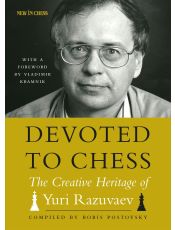A lesson with Yuri Razuvaev
** The following is a chapter from the book Devoted to Chess - The Creative Heritage of Yuri Razuvaev by Boris Postovsky **
The 12-year-old American Daniel Naroditsky, a pupil at the Kasparov chess school, recently became World Junior Champion in his age group and traveled to Moscow with his parents during the Tal Memorial. On one of the days he visited the editorial offices of the magazine 64, to meet with Honoured Trainer Yuri Razuvaev, who had agreed to the youngster’s request to meet with the young student.
– You’ve already been to the Tal Memorial – Yuri Sergeyevich asked the young champion after they had been introduced and sat at the board. Alongside him was a notebook computer with a database of training positions. Daniel was somewhat nervous and initially declined the offer of tea and cake.
– We’re going today.
– Who do you support?
– Kramnik.
– A good choice! Incidentally, Kramnik was a very good player by your age. Even the young Karpov did not stand out like Kramnik. The only player one could compare with him at the same age was Kasparov... What is it you like about Kramnik?
– He’s a very good positional player. This interests me and I have even written a textbook on positional play – announced Daniel.
– Tell me how you learned to play – suggested Yuri Sergeyevich.
– I was about six and a half and played with my brother. We started at the same time and in a couple of years, I had left him behind. Then I went to the club in San Francisco, the oldest in America. Its director is GM John Donaldson. I play tournaments there. My FIDE rating is 2313. I mainly work with trainers over the internet.
– What chess literature do you read?
– A lot. With my dad, I read books in Russian, and in my own English ones. At the moment, I am reading a book by Marin.
– Marin... He’s a bit elaborate, but at your age, you need clearer thinking. I would not get distracted by him. Look at Suba’s books, I prefer him. And you’ve read Kasparov’s books?
– I am just finishing The Test of Time. I really like it.
– Yes, he is unrivaled. And you’ve read Predecessors, of course?
– Not yet. They say it contains a lot of computer analyses.
– No, you’re wrong, it’s his best book. It’s not enough just to know it, you need to keep it with you and re-read it constantly. You can learn to analyze tactics with a computer but to develop your play, you need contact: either by reading or by listening... Every phrase can be the key to understanding a position. Right now, you need to develop an understanding of chess, so it follows that you need to read Kasparov’s books. Although, as his pupil, you can speak to him personally?
– He doesn’t work with us. When you arrive, you go through three games each, but he does not give any advice...
– Botvinnik also met with his pupils only rarely, every 3-4 months or so. At first, I was a pupil at the Botvinnik school, and then I started working as an assistant when I was 22. And of all the people I have met, with the exception of Botvinnik, the one with the best feel for training work was Kasparov. He has a real gift for training. You need to prepare for a session with him, and prepare questions. Then you will get more benefits. How often does he come to the school?
– Once a year.
– Yes, it’s difficult. Do you speak with him on the internet?
– With Sasha (grandmaster Alexander Kalinin – Ed.).
– What do you work on?
– In recent times, we have mainly worked on openings. We worked on 1.e4. Before the World Championship, I did not have a system against the Sicilian, I just played 2.♘f3, 3.g3.
– Now you need to study all openings. In modern chess, you have to be able to play all types of positions and get to grips with all the various kinds of middlegame positions. The more you absorb, the better your positional understanding becomes. This is the reason Ivanchuk can play any opening... Magnus too, from the very start, played everything and this is a big trump. When Kasparov first got into the Soviet team at the age of 16, he had a relatively narrow opening repertoire, but he showed me analyses of all openings, including those he did not play. And when he started advancing, this benefited him. For example, when he used the Catalan for the first time in his match with Kortchnoi, this proved to be a real blow for the latter... Which variation did you prepare against the Sicilian?
– Against the Najdorf, 6.♗g5 e6, and instead of 7.f4 – 7.♕d2.
– Hmmm... There is no need to play 6.♗g5, both 6.♗c4 and 6.♗e2 are good. But if you are going to play 6.♗g5, then you need to learn the main variations. Do you play training games? This is essential. But it is better not to play them against your trainer. Find opponents on the internet. Do you work on a real chess set or a computer screen?
– Both.
– A real set is better, of course. One useful method is to turn the board around occasionally and look at the position through the opponent’s eyes... Do you solve endgame studies? Who are your favorite composers?
– I solve quite a few. I especially love Kubbel’s studies.
– That’s a surprise for me... Let’s try solving a few. If you know the position, just say so, and let’s not waste time. We’ll start with the simplest one.
– I solved this yesterday!
– Spassky loved to demonstrate this study. Bondarevsky once set it up for him and when Spassky solved it, Bondarevsky jokingly said ‘OK, I’ll work with you!’. Let’s try another.
(For a few minutes, Daniel unsuccessfully tried to find concrete variations.)
Have you ever looked at the pawn ending with two pawns against one? No? Dvoretsky starts with this. His Endgame Manual is a book you need to know from cover to cover. Tell me, how should you look for the solution here?
– You have to find the final position.
– Well done! Find a position from which you know an exact win. Think. Moves are not necessary.
– (after a short pause) Pawns on h6 and f4, king on d6, Black to move.
– Well done! This is a position from Gulko-Khalifman, Erevan 1996: 42.h4 ♔e6 43.♔g5 ♔f7 44.♔f5 ♔e7 45.♔e5 ♔f7 46.h5! ♔e7 47.f4 ♔f7 48.♔d6! ♔f6 49.h6. And that’s that.
Sometimes in the endgame, you have to think in schemes. Envisage the final position! This ability helps not just in the endgame. I remember Botvinnik once showing me his game against Stein. After emerging from the opening, a complicated position arose and he said: here it is necessary to exchange two pawns and keep only rook and opposite-colored bishops, exchanging off the rest of the pieces. That’s what he did and Stein only survived by chance. And from whom do you think Botvinnik learned this? From Capablanca. The latter would look at a position and see all its possibilities for structural change in the future and also the position towards which one should strive. You did well, and got the point quickly., Have you looked at Capablanca’s games?
– I’ve read his textbook, but a long time ago.
– What was his main strategic idea, do you think? The battle for control of squares! This is something one must learn from him.
Let us look at a study by Grigoriev.
– I think one needs to play 1.f3 ♔f2 2.♔g4 ♔g2 3.♔f4...
– And then what? I just keep the king behind the pawns and it will be a draw. This mustn’t be permitted.
– Push the pawn to f5 at once? 1.f4 ♔e2 2.f5 ♔f3...
– Are you winning? I doubt it. Direct play does not work, you have to find a way to regroup. Advancing the pawns is pointless.
– 1.♔g2 ♔e2 2.g4 ♔d3.
– This is the most difficult moment. What do you play after 3.♔f3 g5 ?
(Daniel thinks uncertainly.)
– What is the principal difference between the middlegame and the endgame?
– The activity of the king.
– Agreed, but there is also a strategic difference: in the endgame, zugzwang plays a great role. In this case, the idea of a breakthrough has to be combined with the idea of zugzwang. Therefore you have to identify a position of zugzwang first, and then try to reach that position, with the breakthrough idea helping.
(After a long pause:)
– 4.♔g2!
– A brilliant move! Now after 4...♔e4 we reply 5.♔g3, winning, but what after 4...♔d4 ? (Daniel thinks.) New problems...
– We play 5.♔f1!.
– Correct! A beautiful study!
– What do you think, – continued Yuri Sergeyevich – is the most important thing for a practical player in the endgame? What should he study? Consider this: at the end of the game, what time control are you playing? 15 minutes or half an hour, plus 30 seconds per move increment? Both players are tired, and short of time. Therefore you need to know well positions with only a few pieces on the board! Both in terms of their assessment and the methods of play in them. There are many such positions and you need to revise them before a tournament.
Karpov-Istratescu
Bucharest 2005 (m-4)
Black to play.
First, let’s play through the end without commentary.
55...♖g6 56.♔f5 ♔h7 57.♕d3 ♖g5+ 58.♔f6+ ♔h8 59.♕e4 ♔g8 60.♕e6+! ♔h7 61.♔f7 ♖g8
If 61...♖g7+, then 62.♔f8, I control g8, and then 62...♖g5 63.♕e7+ ♔h8 64.♕f7 wins.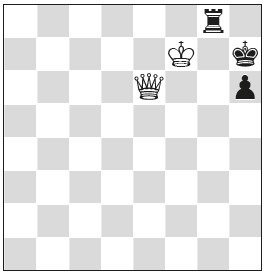
In the diagram position, I pose the question: what if it were White to move? One must just transfer the move to Black!
62.♕f5+ ♔h8 63.♕e5+ ♔h7 64.♕e6
Black resigns.
Convincing, eh? But what is surprising is that the initial position is a draw!
In the 19th century, there was a man called Count Guretzky-Cornitz. We don’t have any of his games, but he carried out a mass of very accurate endgame investigations. Here is one example: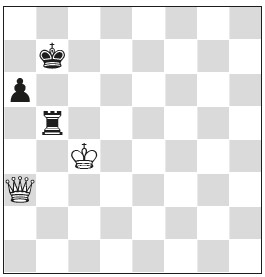
1.♕e7+ ♔b8 2.♕d8+ ♔a7 3.♕c8 ♖b7! 4.♕c5+ ♔b8 5.♕e5+ ♔a7 6.♕d4+ ♔a8 7.♔c5 ♔a7 8.♔c6+ ♔a8
Black can stop the white king from reaching c8! Istratescu only needed to do this and he could have drawn easily.
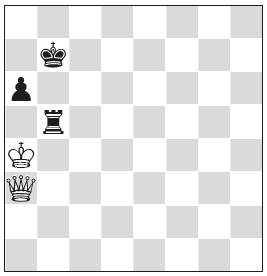
(V.Khenkin)
Here White has a second attacking idea and the position is an easy win. As soon as the rook moves away, we play ♔a5 ! But what if we add a pawn on a5? Then it’s a draw again. But with a white pawn on a5 and the white king on c4? An easy win. Here we don’t need to remember any variations, we just need to know the ideas.
There is a wonderful study by David Gurgenidze.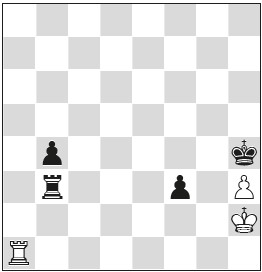
(Here the somewhat tired Daniel encountered difficulties. For some minutes, he could not find the solution to this study, and only after he found the first move by a process of elimination did the rest follow.)
– 1.♖b1! f2 2.♖xb3 f1♕ 3.♖xb4+! Now if the king goes to h5, there follows 4.♖h4+!. If Black brings his king to the f-file then after ♖g4 we have a theoretical draw.
– It is all easy, once you know which position to aim for, isn’t that so? But if you do not know... Look what happened between Kramnik and J.Polgar at Monaco 1994: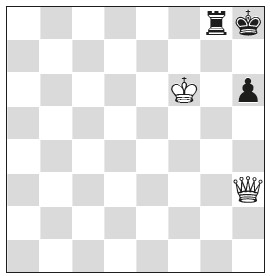
86...♔h7 87.♕d7+ ♔h8 88.♕e7 ♖g5 89.♕f7 ♖g8 90.♕c4 ♔h7 91.♕e4+ ♔h8 92.♕c4 ♔h7 93.♕f7+ ♔h8 94.♕d7 ♖g5 95.♕b7 ♖g8 96.♕b3 ♔h7 97.♔f7 ♖g5 98.♕e6 ♖g7+ 99.♔f8 ♖g5 100.♕f6 ♖g8+ 101.♔f7 ♖g5 102.♕d4 ♖f5+ 103.♔e6 ♖g5 104.♔f6 ♖g8 105.♕d7+ ♔h8 106.♕d2 ♔h7 107.♕c2+ ♔h8 108.♕c5 ♔h7 109.♕f5+ ♔h8 110.♕e6 ♔h7 111.♔f7 ♖g7+ 112.♔f8 ♖g5 113.♕d7+ ♔h8 114.♕f7 ♖g1 115.♕f6+ ♔h7 116.♕f5+ ♔h8 117.♕e5+ ♔h7 118.♕e4+
Black resigned.
There was no time to think and the players did not know the theoretical positions, the result being this shambles. Kramnik got his king to f8, then for some reason brought it back again, before finally he built up enough time to work out what was happening.
But now let’s have a break for 10 minutes or so...
We’ve looked at the endgame. You need to solve more studies and know the key positions in detail. Now let’s look at some other chess aspects. It is useful to know what you remember and what not.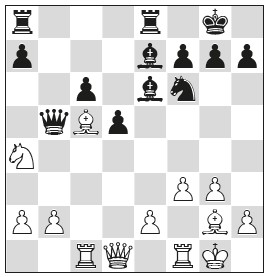
Find a regrouping for White.
... When you are thinking about regroupings, remember Karpov. His attitude to his pieces is like that to his close relations. He is concerned about them the whole time, bad pieces he either exchanges off or improves. Which piece should we be worried about here in the first instance?
– The light-squared bishop. Maybe put it on f1?
– The start of a good thought! How should we do it?
– Probably by putting the rook on e1?
– And if we are more cunning? Where do we want our rooks?
– Doubled on the c-file... Maybe the rook could go via f2?
– Excellent! This is a game Rubinstein-Salwe, Lodz 1908. It went as follows:
16.♖f2 ♘d7 17.♗xe7 ♖xe7 18.♕d4!
– An excellent move, securing the square c5.
18...♖ee8 19.♗f1 ♖ec8 20.e3, etc.
White has a large positional advantage and won. Learn to think about the pieces which stand badly and to regroup them.
Can you calculate variations? You’re not tired?
– No, I am fine!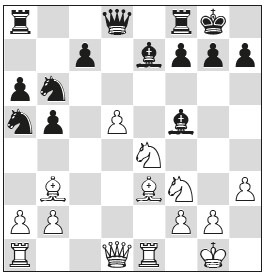
White to play. Find a way to seize the initiative.
– (Quite quickly he answers:)
16.d6! cxd6 17.♗xb6 ♕xb6 18.♘g3 ♗e6 19.♗xe6 fxe6 20.♖xe6 ♗f6 21.♖xd6
– Well done! I’ll play
21...♕b8
Think further, this is a position that needs calculating. Have a cup of tea, think for ten minutes and then show me your decision.
– (A few minutes later:) I think one should continue
22.♘h5 ♗xb2 23.♖b1 ♘c4 24.♖d7 ♖a7 25.♖xb2 ♘xb2 26.♕d5+ ♔h8...
– What’s your next move? Vasily Vasilievich Smyslov loves to generalize. He says there are only three types of tactical weapons: forks, pins, and checks. So, what should you play?
– 27.♕d4! ♖xd7 28.♕xd7 ♖g8 29.♘g5 h6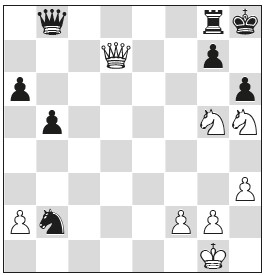
A familiar position has arisen...
– Don’t rush, calculate it all to the end. The variation is long, but forcing.
– (After a few more minutes:) Got it!!
30.♘f7+ ♔h7 31.♕f5+ g6 32.♕d7! gxh5 33.♘g5+ ♔g6 34.♕f7+ ♔xg5 35.g3 ♘d3 36.h4+ ♔g4 37.♕d7+ ♔f3 38.♕xd3+ ♔g4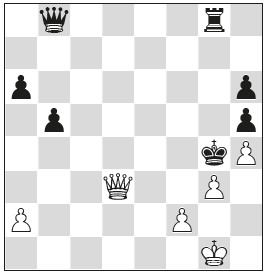
And now
39.♔g2
and mate!
– Very well. In the game Tal-Antoshin, Moscow 1957, Tal missed this combination (and played 31.h4?, which was successfully met by 31...♕c8!). It is strange because the demo-board operators showed it, yet he missed it... In general, Mikhail Nekhemievich did not calculate combinations, he just saw them immediately... I remember once analyzing a complicated position. Tal glanced at it, went quiet then said ‘♖e6’. I looked at the board, and there was no such legal move! But then I looked again and realised that nine moves into the combination, he had found the key move...
How are you with exchanges? Do you work on this? – Yuri Sergeyevich suddenly asked, sternly.
– I’m pretty good – the young champion replied, somewhat shocked.
– Let’s look at a simple example.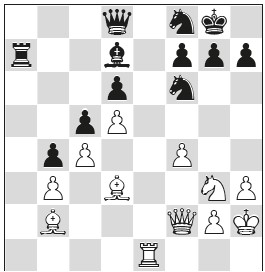
White has a large advantage. Find a plan to develop the initiative.
– ... Maybe we can play 1.♗e5 ?
– An interesting move. Yes, that never even entered my head. But the position is quiet, why get so excited? We are looking for something quieter.
– Then 1.♗xf6! ♕xf6 2.♘e4 ♕h6 3.f5!.
– Excellent! And you found that very quickly. Let us try some other examples...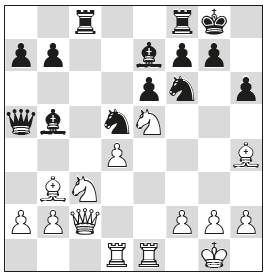
– (Very quickly:) It seems to me that there is a concrete idea here. We need to give up both bishops: 1.♗xf6 ♗xf6 2.♗xd5 and 3.♘g4!.
– Excellent. I can see you have worked... Incidentally, the idea of exchanging bishop for knight for the sake of dynamics was used in another game at the very highest level. Do you know which?
– (After a pause:) A contemporary game?
– Of course, else I wouldn’t have asked. Have a think, I don’t want to tell you... 2000, the Kramnik-Kasparov match.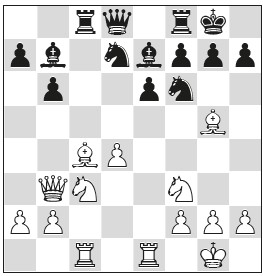
14.♗xf6! ♘xf6 15.♗xe6, etc.
Why did I show you this example? Whenever you see a good game, you should try internally to classify it. Nimzo-Indian Defence, b6-variation with the IQP, a typical position. The device – exchange of bishop for knight, with the aim of increasing the activity of one’s pieces. You need to do this every time, then the material will be lodged in your memory.
Here is another position...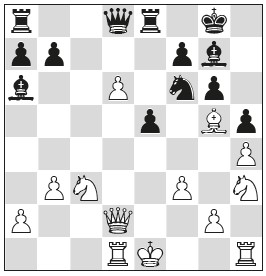
– Kramnik-Shirov, at Cazorla? I saw this in Shirov’s two-volume work...
– Probably I should show you examples from older times. Have you read Botvinnik’s books?
– I have his four-volume set but have not really looked at it much.
– I very much recommend his book on the 1941 match-tournament. [Translator’s note: This book, on the 1941 Absolute Championship of the USSR, was the one Botvinnik himself regarded as his best analytical work. The English edition, published under the title Championship Chess, was out of print for many years, but is now available as a modern reprint, published by Hardinge Simpole.] During the war, he worked as an engineer, and in the evenings he sat down to write this book. Here is one example from it: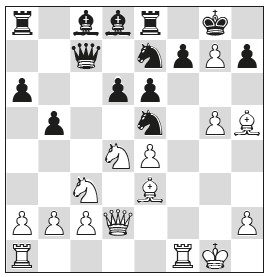
White to move. Choose a plan.
– At first glance, there are dynamics...
– It’s hard to say. I always say that, in the Sicilian, a centralised knight on e5 stabilises the position. In general, e5 is a key square in this opening...
(Daniel suggests several lines, unsuccessfully.) Kramnik, Karpov – how would they realise their advantage?
– They’d strengthen the position...
– Yes! And Kasparov too, in his best games, attacked over the whole board, and so it was extremely hard to defend against him. One must strengthen the position in such a way that the opponent appreciates the hopelessness of defensive actions! Look how Ratmir Kholmov does this against Spassky, Moscow Zonal 1964.
17.b3! ♘7g6 18.a4! bxa4 19.♖xa4 ♗b7 20.♘f3! ♕e7 21.♘xe5 dxe5 22.♖c4 ♔xg7 23.♘a4 ♔g8 24.♗xg6! hxg6
Usually against a strong opponent it is difficult to realise an advantage, because they seek counterplay the whole time. But this is a rare case where there is nothing to realise, as the game virtually falls into White’s lap. The whole black position is shattered. He has two bad bishops, his structure is wrecked and he has no shred of counterplay. Such examples should be remembered and thought hard about!
When we study chess, of course we often enlarge our store of knowledge, about openings and endgames. But it is even more important to improve your style, your method of taking decisions and your general understanding of chess. And examples such as this are the most valuable!
And with that, we must end. Thank you!
